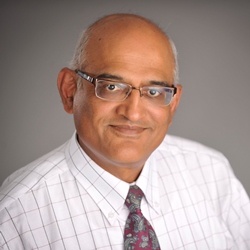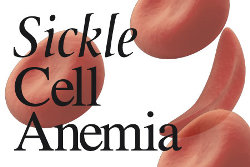You are here
Cord Blood Transplants for Sickle Cell Disease

Sickle Cell Disease (SCD) is an inherited disease of red blood cells caused by a gene mutation involving a single amino acid substitution in the hemoglobin gene. The red blood cells become sickle shaped (see figure below) under stress conditions, leading the cells to stick together and block tiny blood vessels. This can cause pain crises, stroke, and chronic progressive organ damage.
SCD is the commonest inherited disorder in the African-American population. It is estimated that there are close to 100,000 people with SCD in the United States and over 2 million worldwide, mostly in Africa, the Middle East, and India.
The clinical manifestations of SCD can vary from patient to patient, but 10-25% of patients have the severe form of the disease with recurrent episodes of pain crises, recurrent acute chest syndrome, stroke in childhood, and other significant clinical manifestations.
Although over 90% of children born with SCD will survive to adulthood in the US, ongoing organ damage results in a steep rise in mortality in early adulthood such that the median survival for a patient with SCD in the US is in the 40's, almost half that of an unaffected healthy sibling. The prognosis for children born in the developing world is much worse, with the vast majority of children who have SCD dying in childhood, mostly resulting from poor access to comprehensive and quality medical care.
Currently the only curative therapy for SCD is a transplant with blood-forming (hematopoietic) stem cells from a healthy donor. The source of the stem cells can be bone marrow, peripheral blood stem cells, or umbilical cord blood.

Stem cell transplants are increasingly being considered for children and young adults with the severe form of SCD. The results are excellent when the stem cell donor is a matched sibling: less than 5% mortality, 5-10% incidence of graft rejection, and close to 90% SCD-free survival.
After a successful stem cell transplant, SCD patients become symptom-free and can expect to live a very good quality of life. The possible complications of the transplant are: reproductive organ damage, sterility, and perhaps a chronic immune reaction between the cells of the donor and the patient that is called graft-versus-host disease and occurs in about 10-20% of transplant patients today.
When a family has one child with SCD and another who is unaffected, they have the opportunity for the healthy sibling to serve as a stem cell donor for the SCD patient. Thus far, transplants with matched sibling cord blood seem to be just as good as matched sibling bone marrow. Some families may transplant both cord blood and bone marrow from the same donor sibling, in the event that the stem cell count of the stored cord blood is low.
Expectant mothers who have a child with SCD should be counseled and informed about the importance of saving their baby's cord blood for potential transplant of the child with SCD. Since SCD is recessively inherited, there is a 25% chance that the unborn baby may also have SCD, and a 25% chance that he/she will be a tissue-type match to the SCD patient. A number of both public and private cord blood banks offer free storage to families with medical needs like SCD.
Because not all patients have matched sibling donors, researchers have resorted to transplanting SCD patients with unrelated donors found on registries like Be The Match or Be The Cure. These results are not as good as related donors, because of increased complications due to tissue type incompatibility between the donor and recipient. Newer approaches to transplantation are now being explored in several clinical trials for children and adults with SCD who lack matched sibling donors.
SCD patients and parents of children with SCD should know about the ability of stem cell transplants to cure this affliction. They need to be educated and empowered to make decisions regarding therapy in concert with their healthcare providers. I would argue that even though the majority of patients with SCD may not be candidates for a stem cell transplant, it is important to inform patients and their health care providers of this potential option soon after diagnosis so that families can be educated about all potential therapeutic options.


